Will they survive? This was the question that had been constantly on my mind for the past couple of months, and now, as I am standing here in the largest, best-equipped operating theatre of Bangladesh, with the conjoined skulls of the twins in front of me, I can see the convolutions of their brains and the fact that they are alive. Their existence baffled me ever since I met them, but seeing them in the flesh still boggles the mind every time. I wish for them to have a long and happy life. Science and statistics say that the odds for that are less than 50%. They have been under anaesthesia for more than 24 hours, and the work the doctors are performing on them surpasses all records.
We have learned a lot of things about the twins ever since their separation. A little less-known fact is that they have spent nearly seven months in Hungary, if not in secret, but certainly under media silence. The kids conjoined at their heads were brought to Hungary in early January 2019 by the Action for Defenceless People Foundation. The last phase of the series of surgeries, the final surgical separation itself was preceded by 18 months of rigorous preparation. The doctors were secretive, nothing was allowed to jeopardize the safety of the twins. A 35-strong Hungarian medical mission was getting ready to complete the 18-month procedure during the 24-hour surgery to be performed in a far-away and unfamiliar operating theatre. These doctors and select medical professionals could not have anything on their minds other than the great task at hand; the separation of craniopagus conjoined twins is amongst the most difficult medical procedures in the world.
The first half of the mission - eleven people, counting the kids and their parents - arrived at Dhaka a week before we did. Just like them, we also had to change flights in Dubai. As we were in line for boarding our plane to Dhaka, we realized that the thus-far glamorous airport had somehow changed around us, making it apparent that Dhaka is a different sort of destination, our fellow passengers mostly seem to be commuters. As I was waiting in line at one of the checkpoints, somebody tried to hand me a package, asking me to take it through. It was just a plastic bag, but that is a bit too risky for an international airport. That shattered my remaining semblance of a sense of security, though I was already well aware that Bangladesh is not exactly a popular tourist destination. From the moment we left our plane, we were escorted everywhere by a troupe of armed bodyguards.
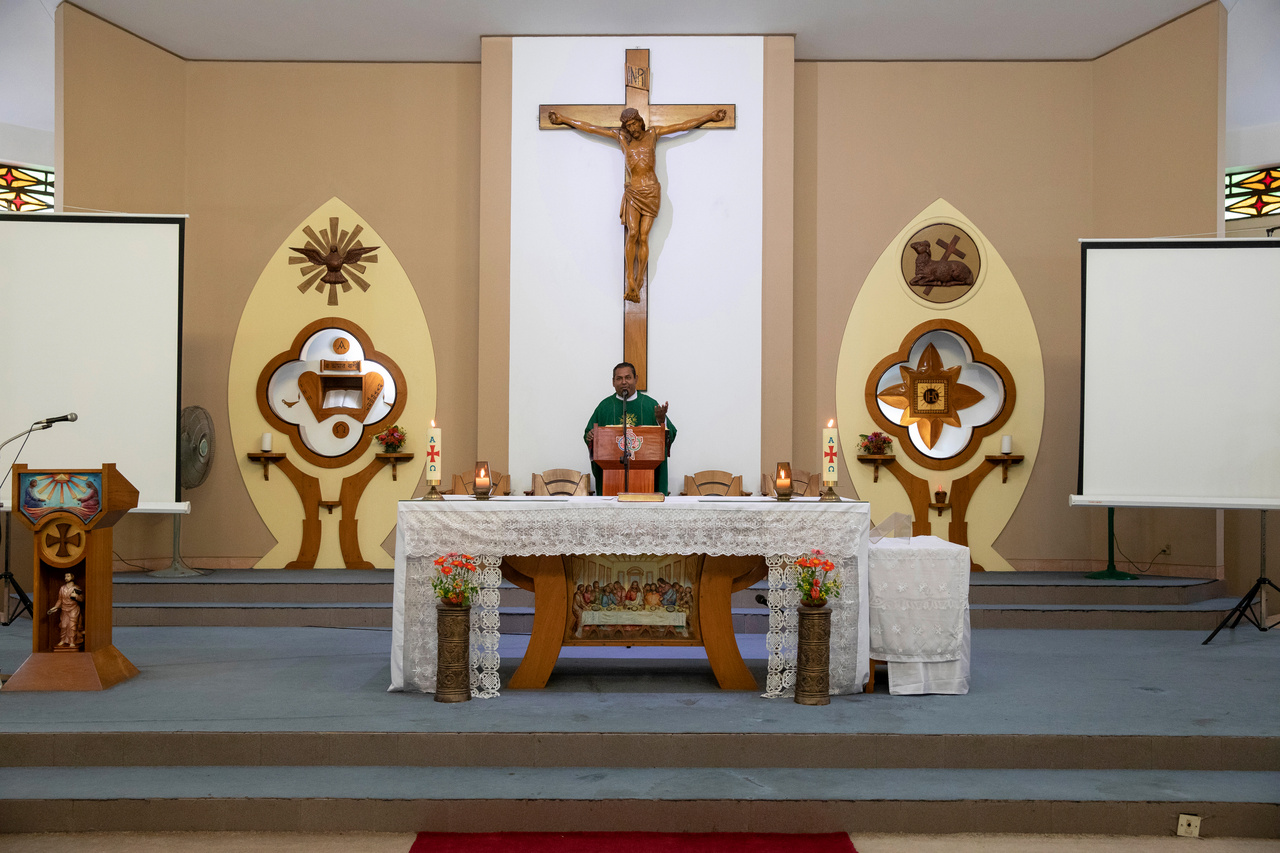
The doctor spearheading the operation, neurosurgeon Dr András Csókay is a religious man. So are the family of Rabeya and Rukaya, although they follow a different faith, which, as their surname would suggest, is Islam. When Dr Csókay spoke of God, the mother of the twins, Taslima spoke of the same feelings, only in accordance with her own religious convictions. On the Sunday before the surgery, the Hungarian team attended a catholic sermon for the success of the operation in a church of Dhaka. The team had a mailing list which Csókay often used to call his colleagues to prayer.
"When facing great challenges, the most common mistake is comparing ourselves to others, wanting to be better than them, no matter the cost. This distracts us from God, from Jesus, from the Holy Spirit living within us, in one word: from our self-identity, and it prevents us from performing to the best of our talents because comparison leads us to judgement, which leads us to pride or inferiority complexes. That is when we lose our quality of being made in the image of God, that is when we become just mere hulls. This is a difficult spiritual work. You can only disconnect that with prayer."
(Fotó:
Szabolcs Barakonyi / Cselekvés a Kiszolgáltatottakért Alapítvány)
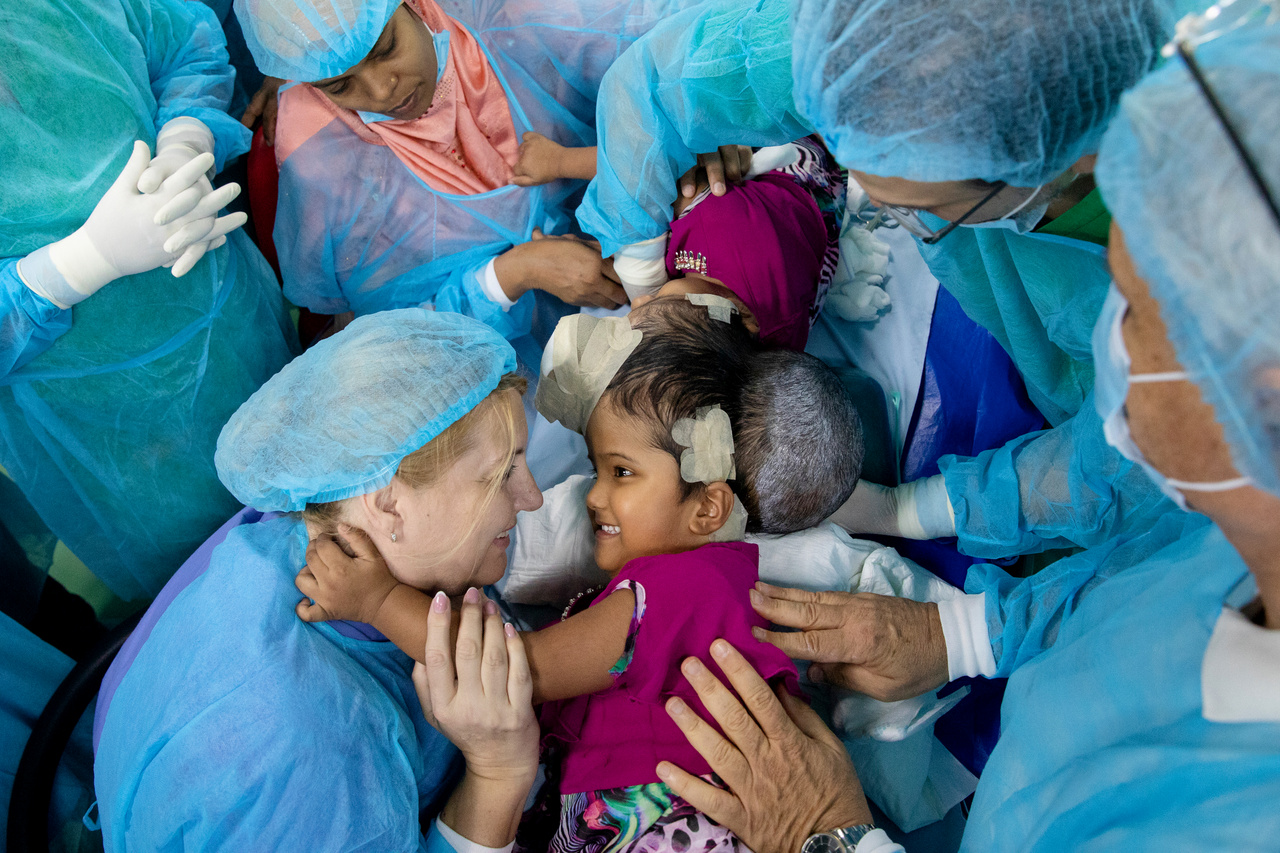
Plastic surgeon Dr Gergely Pataki led the 44 operations that made it possible to grow the volume of the special tissue expander system that was implanted with endoscopic assisted minimally invasive technique under the scalps and soft tissues of the twins to an unprecedented size. Growing the twins' own tissue in this manner allows doctors to cover up the sizeable wound that would be left behind by the final separation. Ever since January, the twins have two moms: there is a 'Mama' and a 'Mother,' the latter one being team member Marianna Ilcsik who spent every waking hour in the past two months with the girls. The strange shape of the girls' heads is not a disorder, what you can see on the pictures are the tissue expanders under their skins - as they are inflated, they help extra scalp tissue grow which can later be used to cover up the top of the twins' heads. The saline-filled silicone implants grow cubic centimetre by cubic centimetre, with fills occurring twice every week first, then only once every week until the expander implants reach the volume of three and a half litres. Initially, these operations happened under anaesthesia at the Semmelweis University in Budapest, but later on, the girls got used to fills being performed with only local anaesthetics. It may be surprising, but the two kids were gleefully running around right up until the last moment, even with this added weight, despite doctors being certain that they will spend the last few months laying down in bed. The tissue expanders were filled in Bangladesh two days before the operation, and once more for the last time, already in the operating theatre where the separation was set to take place. (Fotó:
Szabolcs Barakonyi / Cselekvés a Kiszolgáltatottakért Alapítvány)
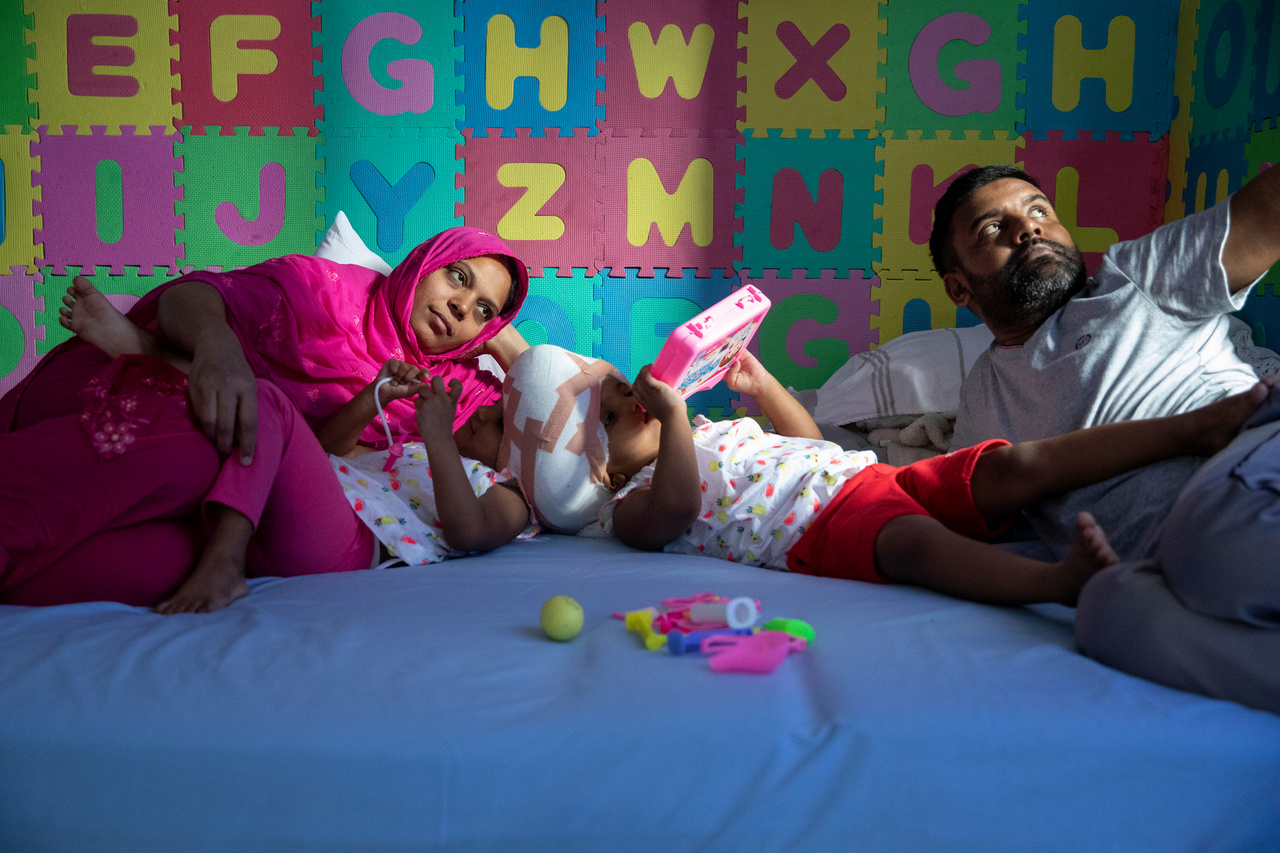
The mother of the twins, Taslima is a school teacher and the father, Rafiqul, teaches bible class. The family used to live in a rural area far away from the capital, and the screenings during prenatal care did not show that the twins are conjoined. They knew that they were expecting twins, but their condition was only noticed during childbirth. When the family arrived back in Bangladesh at the end of July, instead of going home, they went to a specially equipped hospital room set up by the foundation. None of them was allowed to leave the room as the risk of infection was one of the many perils of the complicated operation, and it could only be averted by isolation in a sterile room. Pictured here you can see Rafiqul closing the curtains after Rabeya and Rukaya have received their breakfast with the added special, vitamin-rich formula. A few minutes later they were fast asleep. (Fotó:
Szabolcs Barakonyi / Cselekvés a Kiszolgáltatottakért Alapítvány)
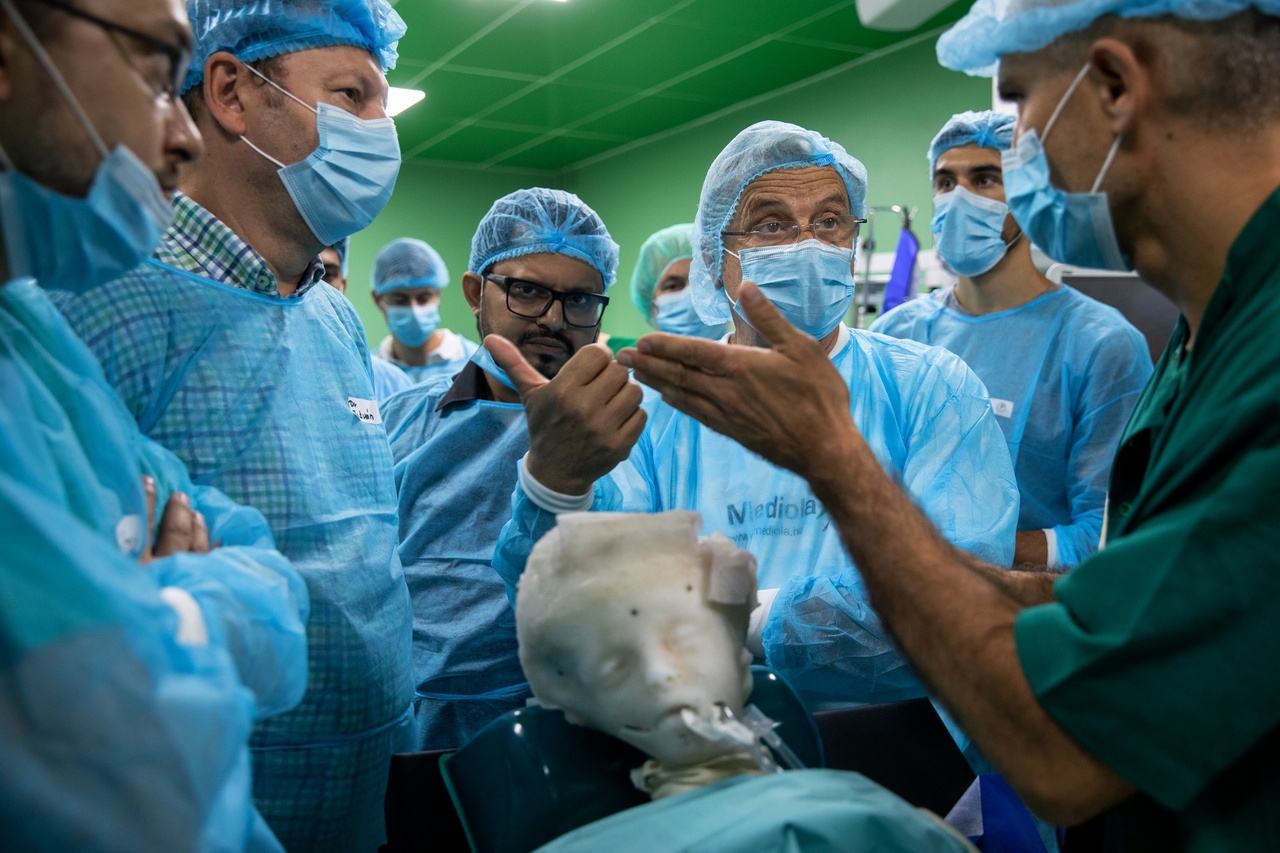
A team of Hungarian and Bangladeshi doctors hold council over the 3D-printed expander model of the twins. (From the left: Dr Gergely Pataki, Dr István Valálik, the Bangladeshi plastic surgeon also participating in the operations in Hungary Dr Hossain Imam, Dr András Csókay, Dr Artúr Kalatovics, Dr Attila Jósvai). Seeing them prepare for the operation reminded me of a scene from the movie Apollo 13 when, due to rapidly increasing CO2 levels, the astronauts had to make a square filter work with a round filter compartment by improvising a solution with materials available onboard. The 18 months preceding the surgery was nothing but finding solutions to endlessly complex problems. Beyond the brilliant medical ideas, doctors employed 3D modeling, graphic design, assessed publications, conducted analyses and autopsies to figure out the details of the surgery. Parts of the brain that were thus far invisible had to be made visible in order to understand what could occur during the surgery and what these occurrences could lead to. What are the risks? Are they life-threatening? If they are not, could they cause irreparable damage? Besides different models, the team took two practice dolls to Dhaka as well, which was useful to rehearse all the minute details of the operation. Every night, the doctors got together in smaller groups to try and map out all the critical moments of the surgery that they did not yet take into account. (Fotó:
Szabolcs Barakonyi / Cselekvés a Kiszolgáltatottakért Alapítvány)
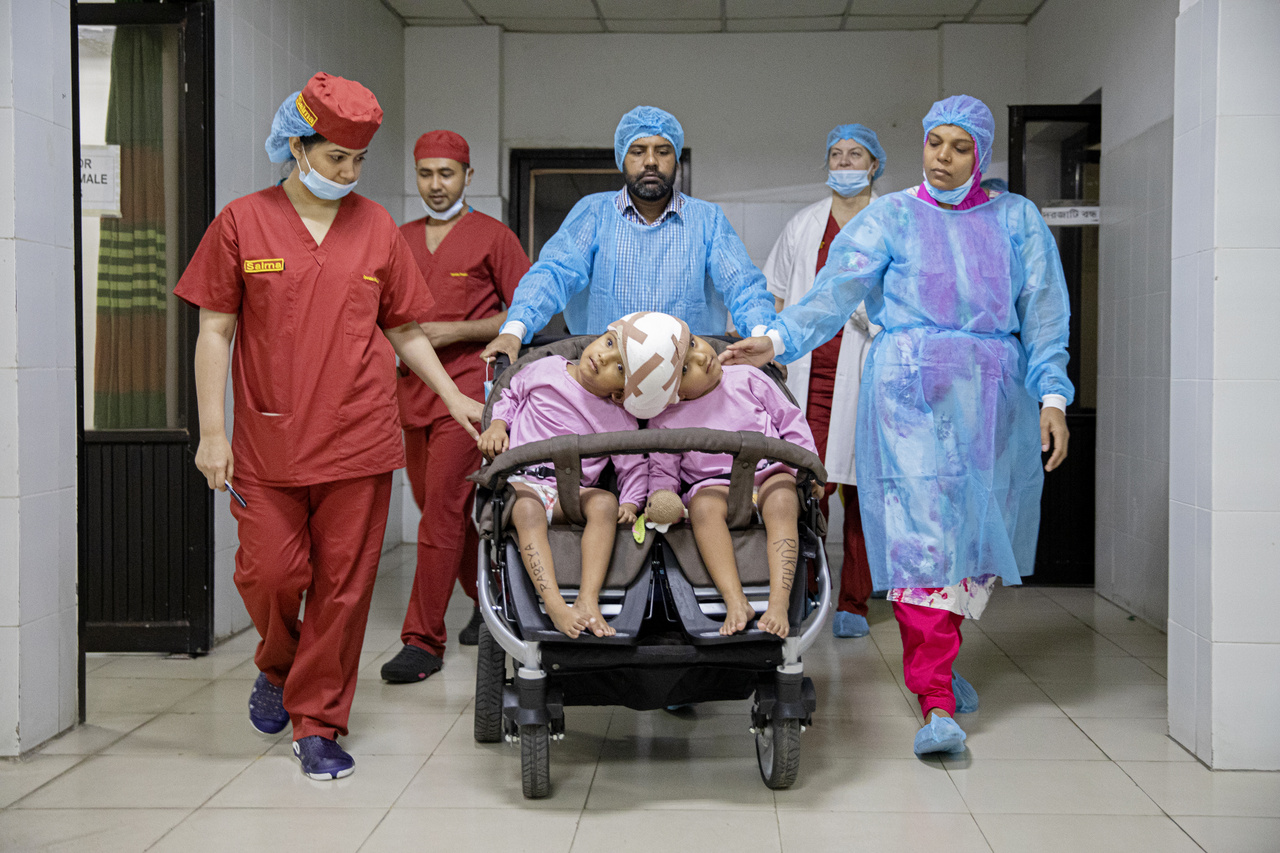
It's a rare moment to see the girls from the front, not only because of their restlessness but because it is nearly impossible to see both of their faces at the same time. It is clearly visible how awkward this position is for their necks, but this is how they have to be most of the time, as this is probably the most acceptable and comfortable position for both girls apart from laying on their backs, though doing that awake is not exactly "comfortable and acceptable" for any three-year-olds. The photo above also shows how Rukaya is physically stronger, and Rabeya's gaze reveals her to be the more curious and alert one of the pair - she is also in control most of the time. (Fotó:
Szabolcs Barakonyi / Cselekvés a Kiszolgáltatottakért Alapítvány)
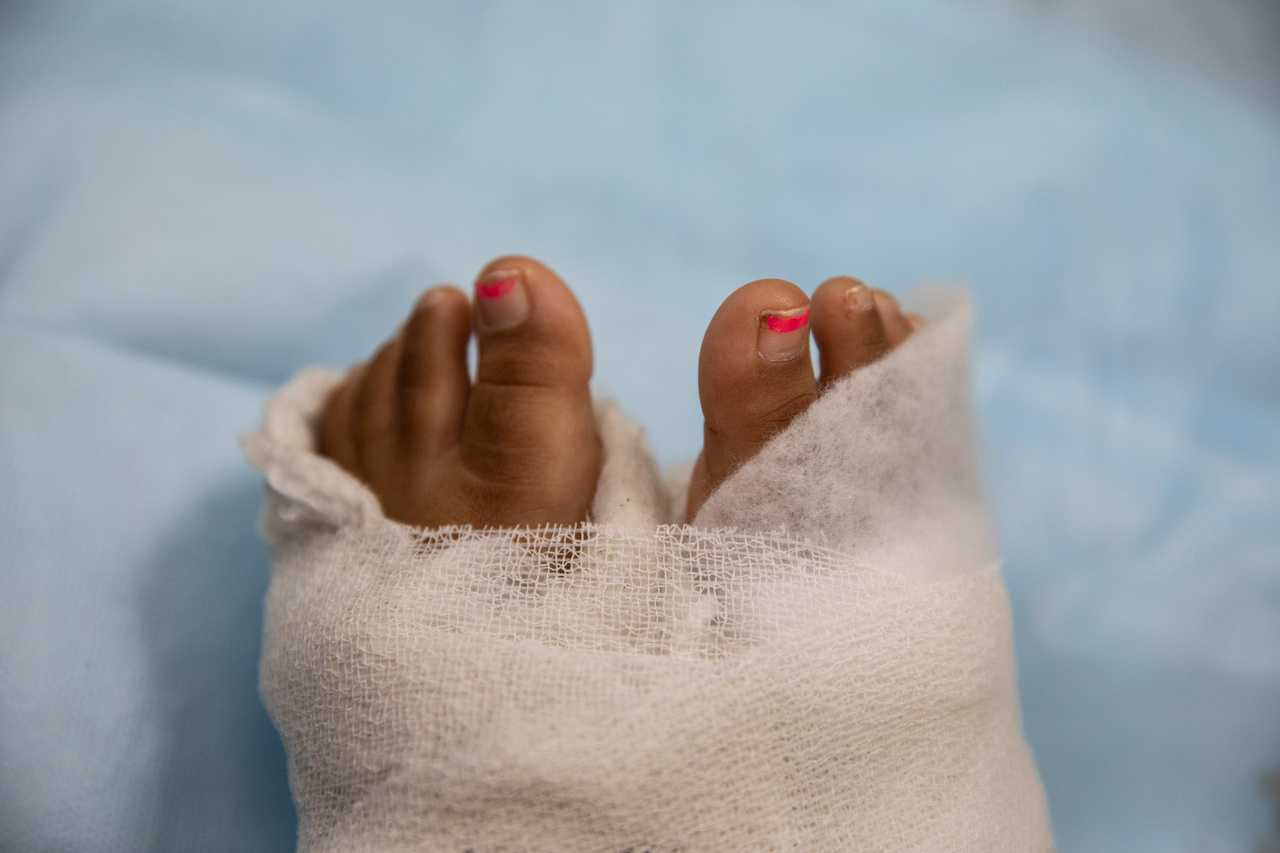
An important takeaway from the surgery rehearsals was that it would be much easier to move the girls during operation if they were gauzed up with their arms secured to their bodies, and this could also protect them from hypothermia. Rabeya's feet hanging out from under the bandage still bear the signs of the previous day's playtime: a little bit of nail polish. I saw the girls play several times, and while they did have their care-free moments, but most of the time it was obvious that only one of them is making the decisions. That was usually Rabeya, the sister with a stronger personality, even if Rukaya could probably have overpowered her. There are examples of Siamese twins living conjoined for decades, but their life is usually not characterised by harmony and quality of life. In the case of Rabeya and Rukaya, there were several bioethical and scientific arguments supporting separation, as it is apparent that the sisters' personalities are completely distinct. (Fotó:
Szabolcs Barakonyi / Cselekvés a Kiszolgáltatottakért Alapítvány)
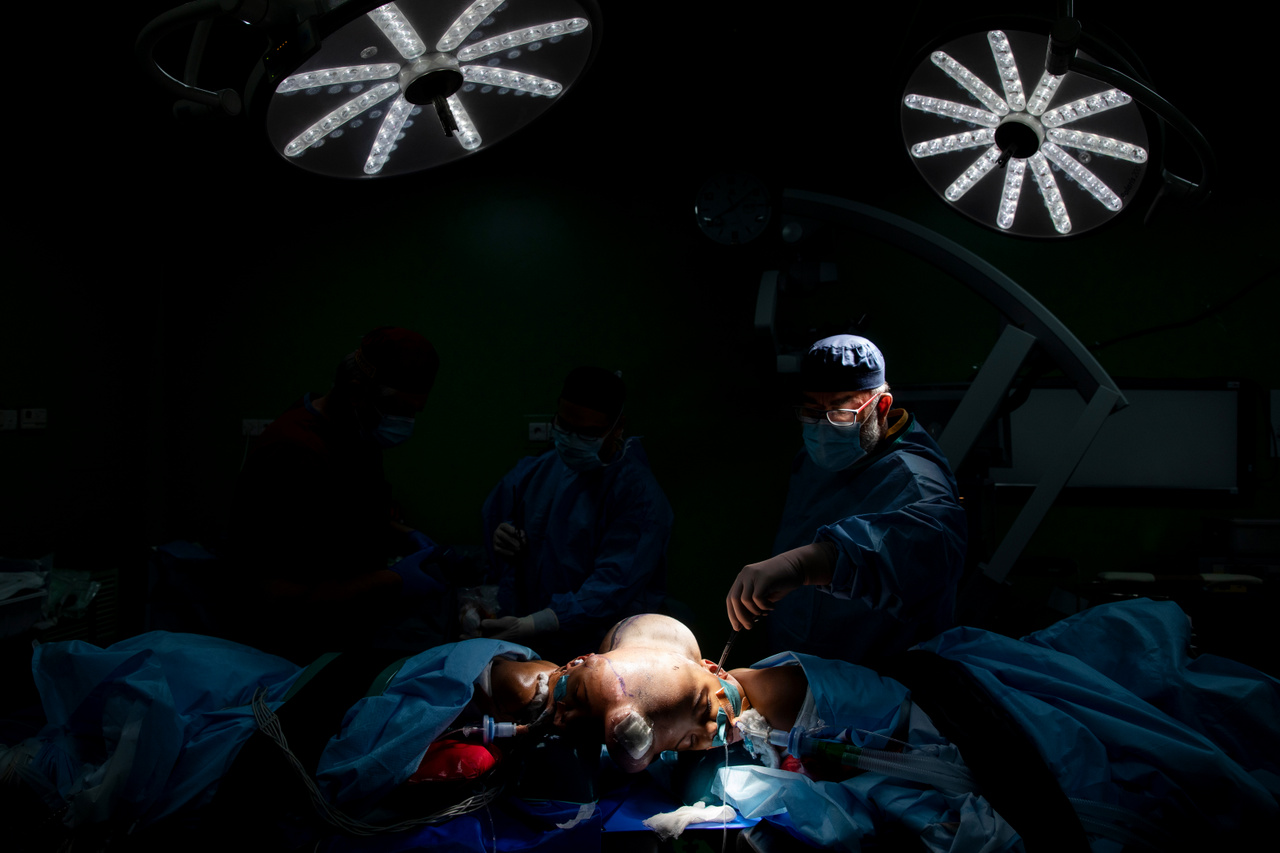
A team of Bangladeshi and Hungarian anaesthesiologists and intensive therapy specialist doctors led by Hungarian Dr Marcell Csapody commenced anaesthesia at early dawn. The girls' posture does not make their job any easier - their airways are not straight, so intubation in itself is an exceedingly complicated task. As the children would be rotated along the axis of their spines during surgery, all the tubing required for anaesthesia, medications, and maintaining steady breathing would have to be rotated as well without getting tangled. The next task was the preparation of the surgical site: the girls' heads were shaved and disinfected with an alcoholic solution. Dr Attila Fekete is pictured here placing silicon gauze into the sisters' ear canals to prevent the disinfectant from dripping in there. You can see both the front and rear tissue expanders and the incision lines marked on the scalp. The Hungarian team of plastic surgeons is in charge of beginning and finishing the operation. In order for the separation process to begin, the doctors have to reach the bare skull itself. They remove the tissue expanders, and just like if it was a carefully planned sewing pattern, they cut and divide the scalp grown over the course of six months in Hungary between the sisters. There is no room for error, as the scalps have to seal accurately, there cannot be any less or more skin on either side. (Fotó:
Szabolcs Barakonyi / Cselekvés a Kiszolgáltatottakért Alapítvány)
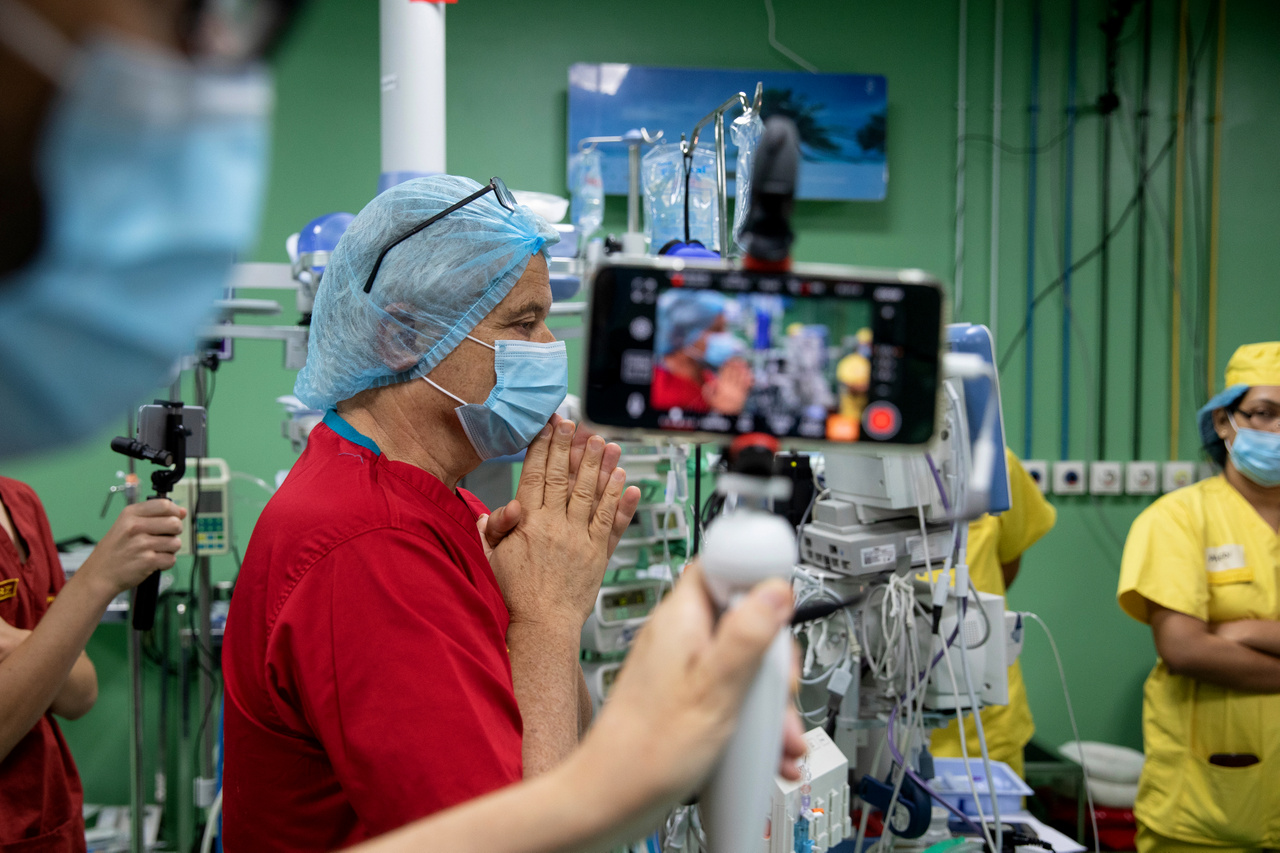
Prayer and the doctors' faith are a constant presence in the surgical theatre. Dr András Csókay requested the team to pray at the start of the operation, when the twins were rolled over, and also before opening up the skull. He was the first to say the lines of the prayer, and his colleagues repeated them after him. The medical team carefully documented all 33 hours of the surgery, as the mission felt like it was their duty to record every moment so it would be accessible later for scientific interpretation. (Fotó:
Szabolcs Barakonyi / Cselekvés a Kiszolgáltatottakért Alapítvány)
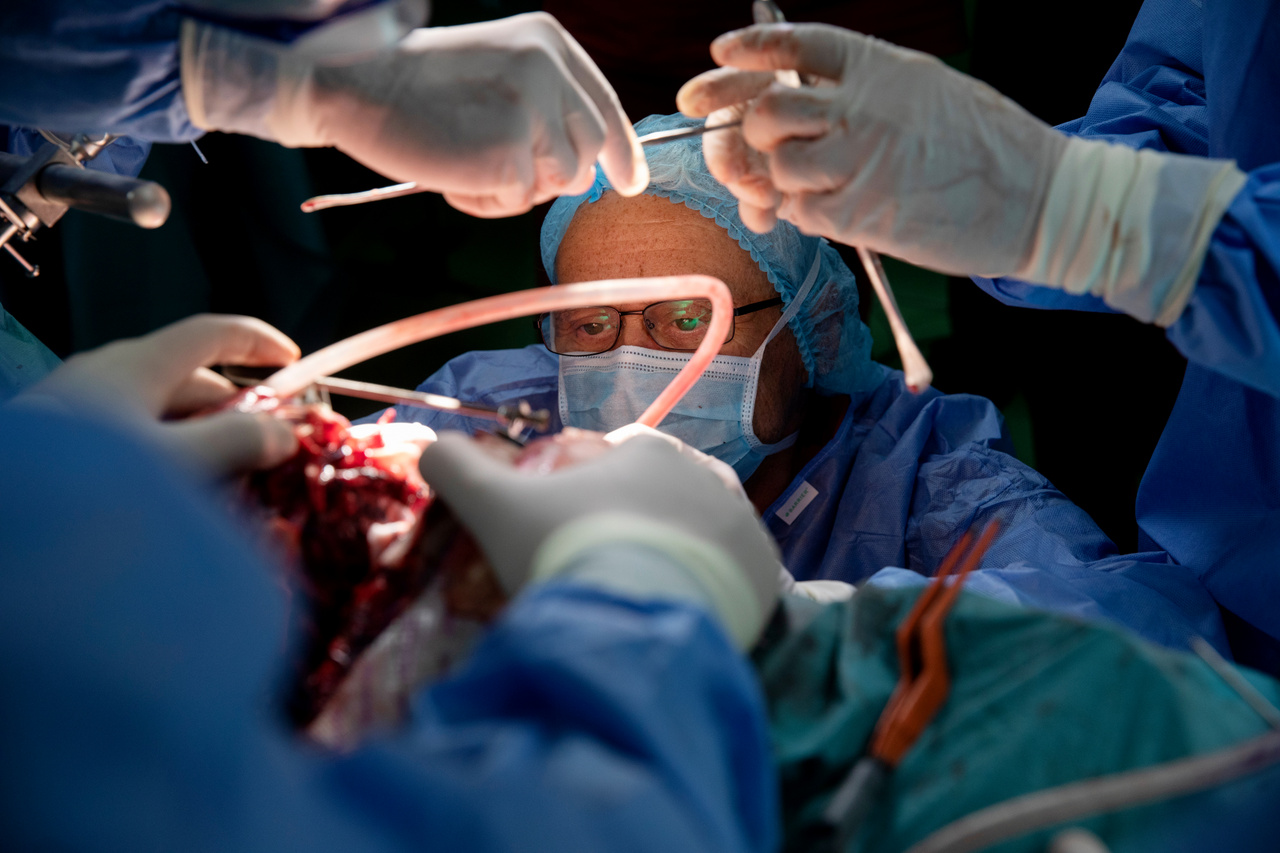
The foundation's doctors used all the latest available medical technology to map the brains of the twins. The life-sized model accompanied them to the surgical theatre as well, as the doctors were studying them during the procedure as well, drawing conclusions from comparing the models to what they have found during the operation. The models were created from MR and CT images of the neural pathways, the network of cerebral arteries and veins, but also of the tissue expanders and the scalp. Neuro- and plastic surgeons used these models to memorise the structure of the twins' heads and brains. Dr Csókay is an experienced surgeon with thousands of brain examinations under his belt. The leading neurosurgeon was up for 24 hours, he had a plan, and he trusted the ability of the young brain to do incredible things, as the younger an organ is, the easier it regenerates and redistributes functions between different brain areas. The neurosurgery progressed with incomprehensibly tedious, slow movements. The medical team had to find a way in between the two conjoined, microscopically thin meninges. (Fotó:
Szabolcs Barakonyi / Cselekvés a Kiszolgáltatottakért Alapítvány)

Doctors Csókay and Trencsényi hold the separated brains with a sponge-covered special tool as Dr Pataki removes the last isolation foil and the clips holding the scalp flaps of the twins together. Pictured here is the moment of separation: at exactly 6:00 AM on 2 August 2019, there is nothing that physically binds Rabeya and Rukaya to each other, and their condition is stable. After many critical moments, success seems more and more probable. The two special tools are originally used in thoracic surgery to create an opening between the two lungs, but now they are used to hold the sisters' brains to prevent them from falling out of their skulls due to gravity, as the support is gone - until now, they were held in place in part by the girls' craniums, but mostly by each other's brains. The two organs are completely bare here, both the tougher outer membrane and the leptomeninges have been removed - they would later be replaced by a hard artificial membrane that is as durable as sailcloth. (Fotó:
Szabolcs Barakonyi / Cselekvés a Kiszolgáltatottakért Alapítvány)
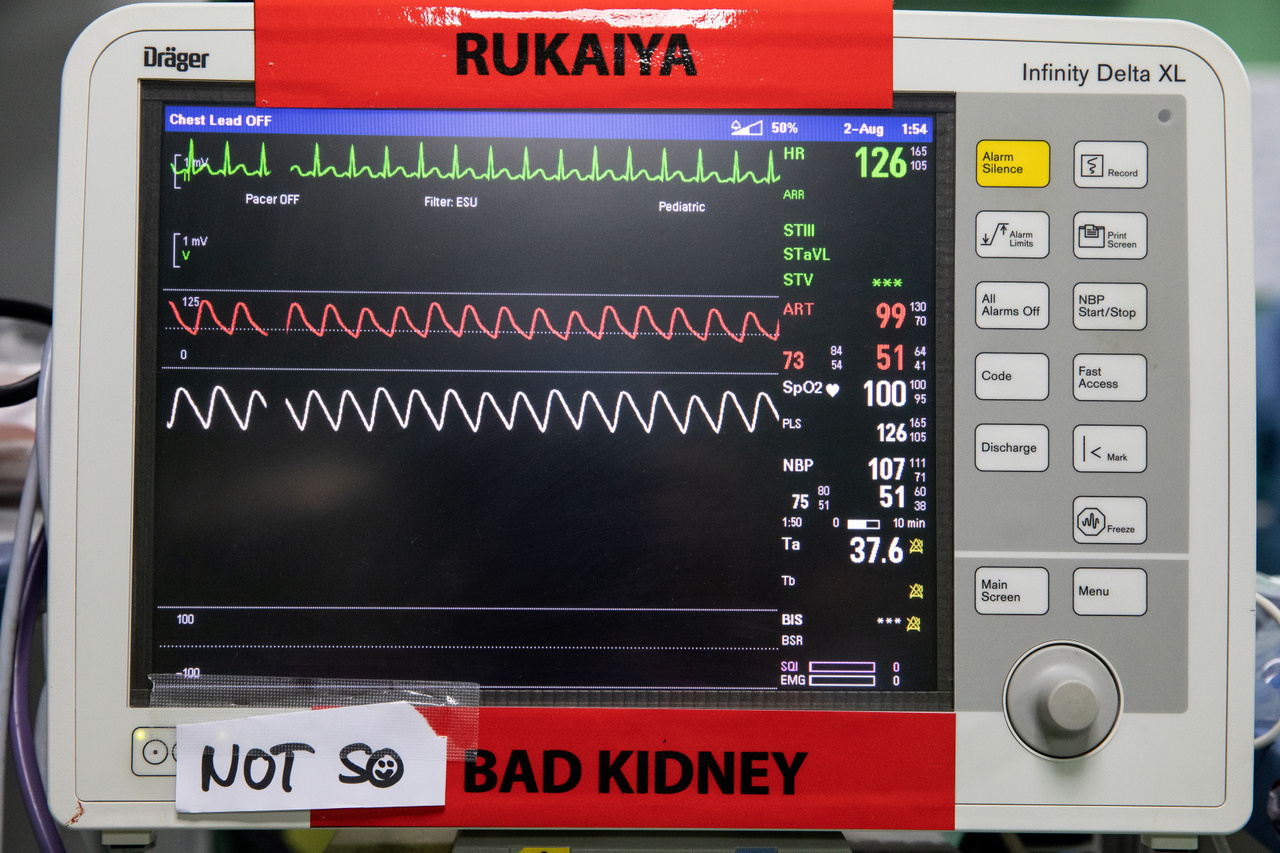
Rukaya's surgical vital sign monitor. She is the larger of the two, but her health is weaker. The preliminary examination showed that Rukaya's underdeveloped kidney could have put her at risk of having to undergo dialysis after the separation. Before the surgery separating the twins' shared cerebral veins, Rukaya's kidney was underperforming, and Rabeya's kidneys filtered most of the blood circulating in both bodies, and for this, blood could only pass through their scalps and the shared blood vessels in their brains. These shared cerebral veins were separated in Bangladesh by Hungarian surgeon Dr István Hudák, but Rukaya exhibited signs of low kidney function afterwards. The anaesthetic machines are labelled to show which girl's values need extra attention due to the weaker kidneys, but throughout the operation, the weaker kidney seems to have been doing its job, Rukaya passed satisfactory amounts of urine, and all figures pointed to regular kidney function. Under the stress of the operation, the team of Hungarian anaesthesiologists updated the labelling accordingly. (Fotó:
Szabolcs Barakonyi / Cselekvés a Kiszolgáltatottakért Alapítvány)
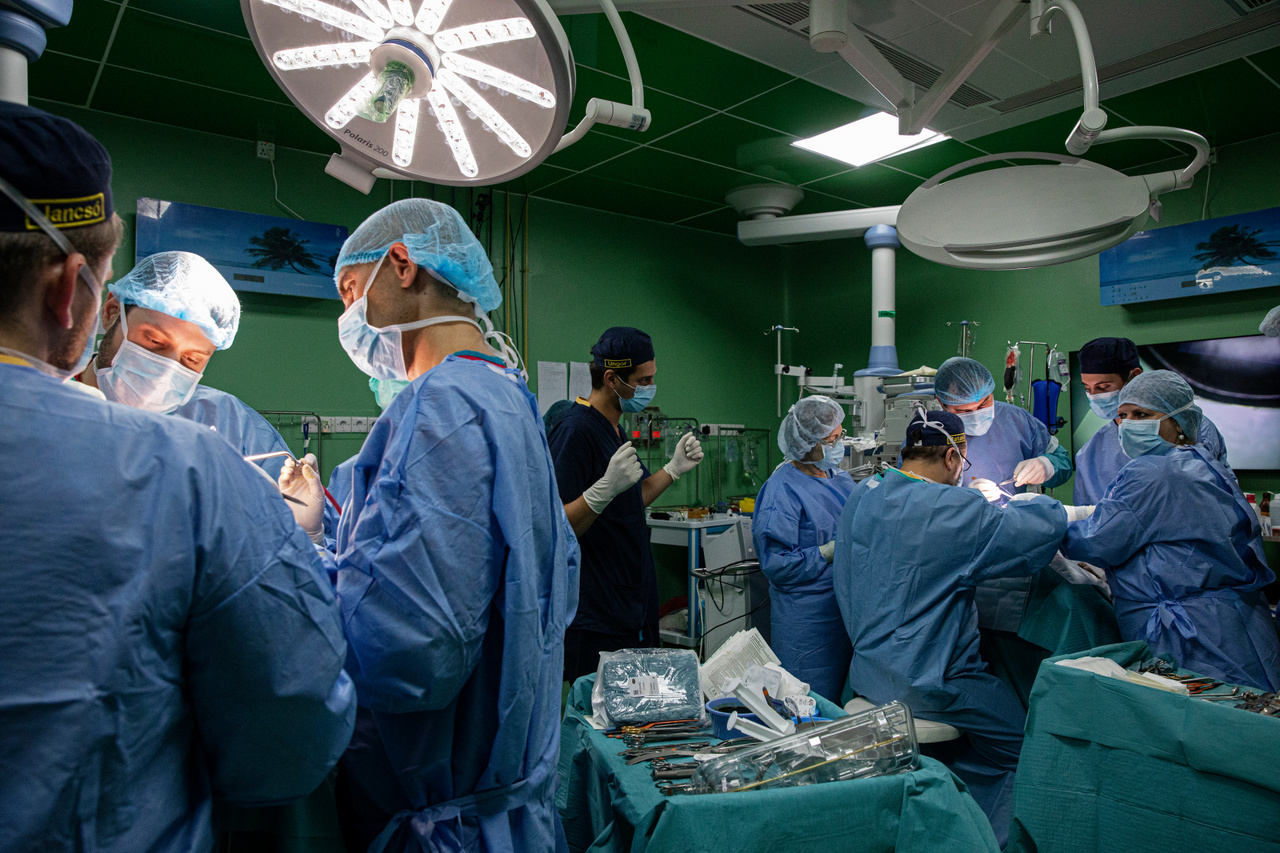
Several hours have passed since the separation, however, nothing is over yet. It was the team of plastic surgeons who began the surgery, and they are the ones to finish it as well; after the partial reconstruction of the skull, they use the tissue grown in Hungary to cover the top of the twins' heads, though it will still take a number of years until the series of operations finally finish. For a while, the sisters will have to get around in a device somewhat similar to a helmet before the reconstructive surgery can begin as hoped. Their skulls can only be rebuilt gradually, through another string of surgeries employing special methods and biocompatible materials that would replace the bone. Dr András Csókay once said that it is easier to understand how the twins were separated if you compare it to climbing: The foundation's mission might have reached the summit of Mount Everest, as covering the heads with the scalp is the equivalent of the last phase of the bid for the summit. But from that point on, it will be Rukaya and Rabeya who will have to make it down from the mountain, their bodies will have to overcome complex physiological problems, and their lives are still not completely out of danger. (Fotó:
Szabolcs Barakonyi / Cselekvés a Kiszolgáltatottakért Alapítvány)
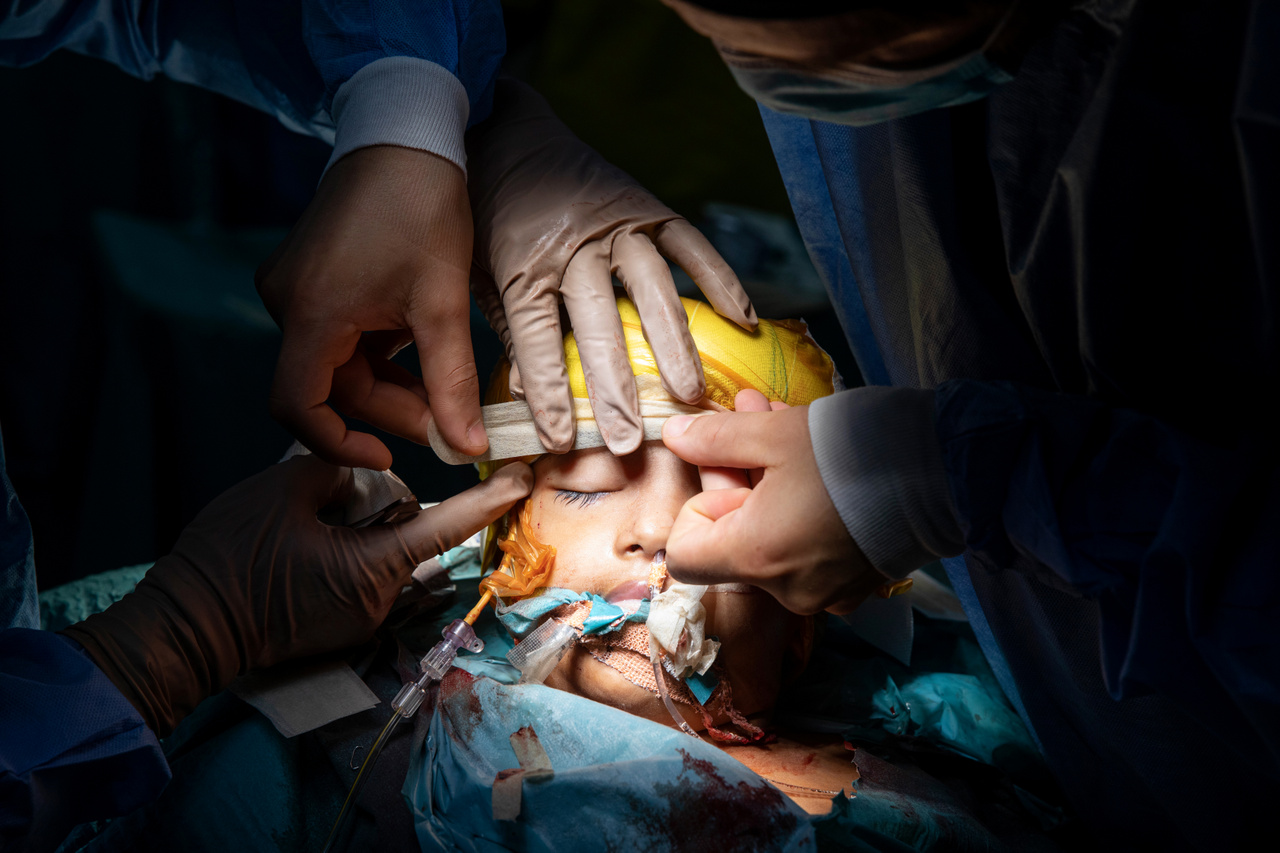
This is Rabeya receiving her special bandage after the surgery concluded. Her sister, Rukaya has a lower chance for complete recovery. Her condition remained critical for weeks after the operations. There are complications doctors can anticipate, however, nobody expected Rukaya to contract viral fever while she was still in critical, life-threatening condition. (Fotó:
Szabolcs Barakonyi / Cselekvés a Kiszolgáltatottakért Alapítvány)
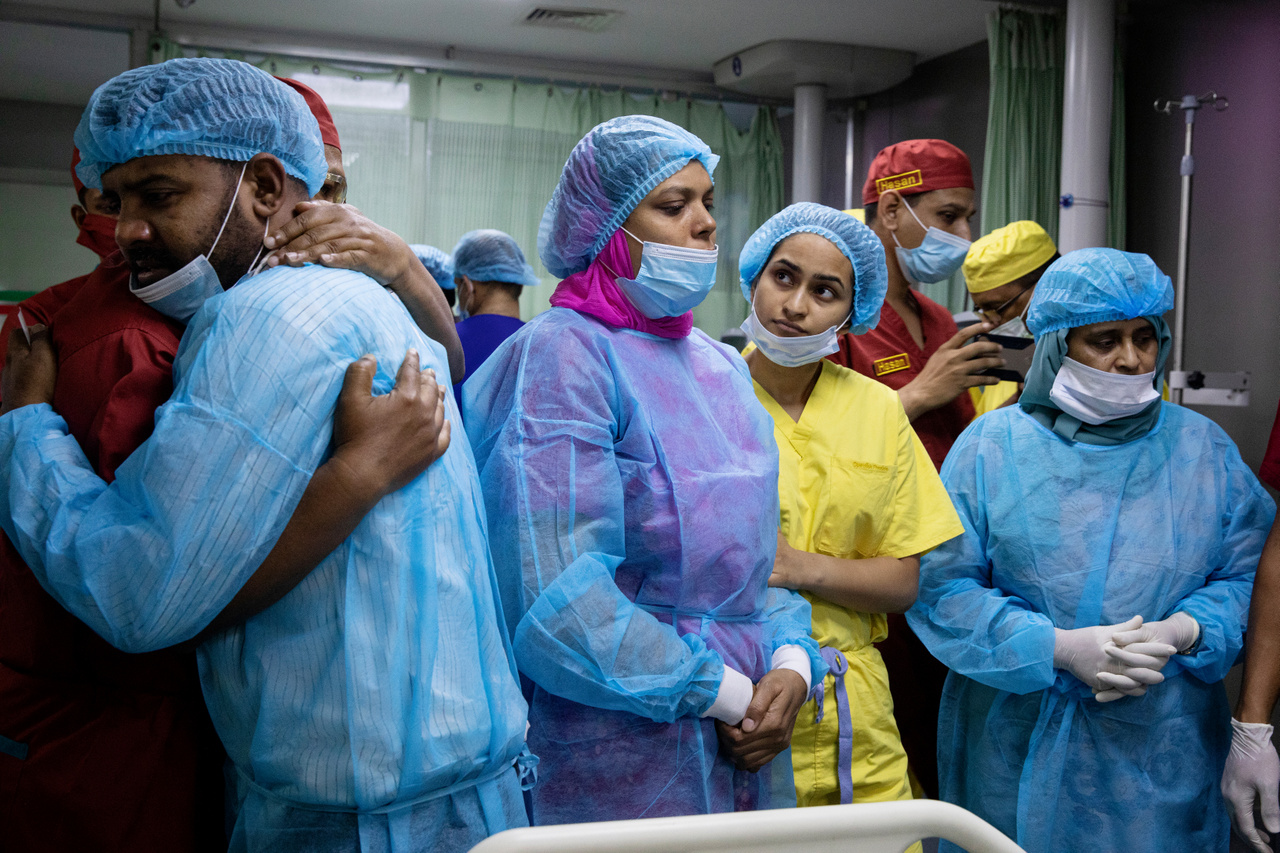
Seeing their children sleeping in separate beds for the first time comes as a shock to the parents. The couple is getting constant, and very detailed information about the condition of their children - they were told that the girls may have endured the greatest challenge of the procedure, however, they will still face many hardships. Cognition of the twins could not yet be assessed, and it is not known to what degree they can be rehabilitated. Pictured here is Sanjida Kamal, the psychotherapist who will be helping the twins along their road to recovery in Bangladesh - she was provided special training by the foundation in Hungary. Next to her is chief consultant neurologist Dr Anjuman Ara. (Fotó:
Szabolcs Barakonyi / Cselekvés a Kiszolgáltatottakért Alapítvány)
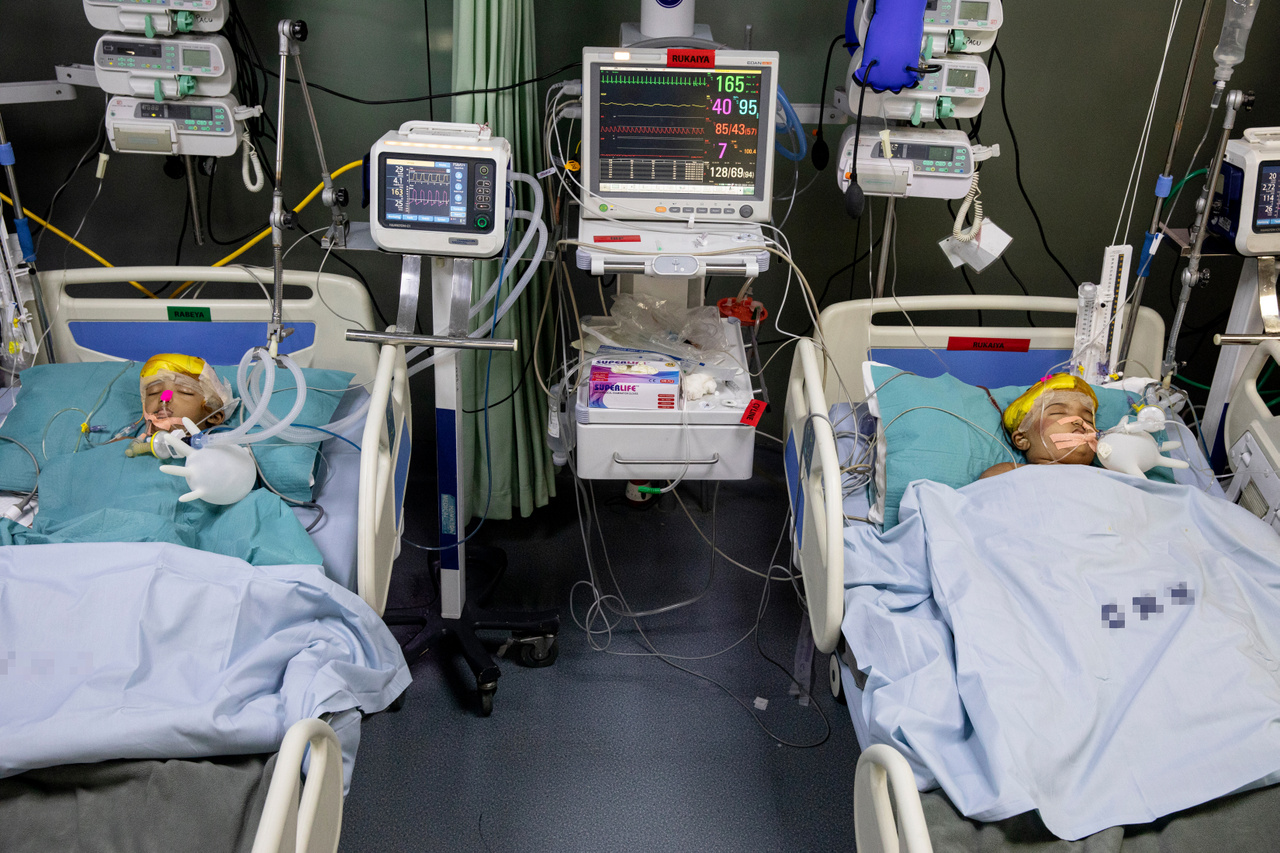
The twins laying in separate beds at the children's ICU after the surgery. They still had to wait though to emerge from anaesthesia as they were still under intense medical observation. The inflated latex gloves serve as improvised support for the respiratory tubes. (Fotó:
Szabolcs Barakonyi / Cselekvés a Kiszolgáltatottakért Alapítvány)
"Rabeya regained consciousness after five days, and since then, she had been playing and talking, and she was already released from the ICU - On day 33 after the final separative surgery, Rukaya suffered a severe brain haemorrhage caused by coagulatory problems prompted by the return of previously successfully treated infective complications. As a result, the condition of the child that was on the verge of regaining consciousness had significantly deteriorated at the beginning of September. Dr Csókay and dr Pataki returned to Bangladesh in September and have performed a five-hour surgery involving cranial and soft tissue reconstruction on both separated children. By the end of the month, Rukaya's condition improved continuously, she is now capable of moving her limbs and opening her eyes, and we are hopeful that she will get to leave the ICU shortly. As of yet, no responsible statement can be made about the anticipated extent of her recovery," the project's chief coordinator Dr Gergely Pataki told Index.
Update: As of 24 October 2019, Rukaya was also released from the ICU.
Operation Freedom is a joint Hungarian-Bangladeshi Project for separation of craniopagus twins (conjoined twins fused at the head) Rabeya and Rukaya. The Hungarian medical team of the Action for Defenceless People Foundation (Cselekvés a Kiszolgáltatottakért Alapítvány) performed the third phase of Operation Freedom, the final, 33-hour separative surgery. I was present in the surgical theatre as a volunteer for the foundation.
The following list can only be republished by citing the source: Action for Defenceless People Foundation „Cselekvés a Kiszolgáltatottakért Alapítvány – cselekves.org”.
- Team Leader In charge of leading the neurosurgical team and the final separative surgery: Dr András Csókay PhD, neurosurgeon.
- Chief Coordinator of Operation Freedom and the team of plastic surgeons: Dr Gergely Pataki surgeon, plastic surgeon.
- The leader of the anesthesiological and intensive therapy team: Dr Marcell Csapody.
- Members of the neurosurgical team: Dr Attila Fekete, Dr Péter Vancsó, Dr Csaba Kunos, Dr Artúr Kalatovics, Dr Máté Jancsó, Dr Bence Lajtos, Dr András Petrovics, Dr András Ungor.
- Members of the anesthesiological and intensive therapy team: Dr Erzsébet Ezer, Dr Katalin Szenohradszki.
- Members of the surgical team, assistance: Marianna Ilcsik, Enikő Czirják, Zsuzsanna Karsza-Kiri, Ibolya Mogyorósi, Margit Csenteri, Imre Szabó, József Pejkó, Balázs Muhari-Papp, Bernadett Csókay, Veronika Vancsura.
- Pediatric psychologist: Zsuzsanna Császár
- Head of Communications: Alexandra Valéria Sándor
Ne maradjon le semmiről!
Follow the English edition of Hungary's largest independent news site on Facebook.
Ebben a cikkben a téma érzékenysége miatt nem tartjuk etikusnak reklámok elhelyezését.
Részletes tájékoztatást az Indamedia Csoport márkabiztonsági nyilatkozatában talál.
Support the independent media!
The English section of Index is financed from donations.

Kövesse az Indexet Facebookon is!
Követem!
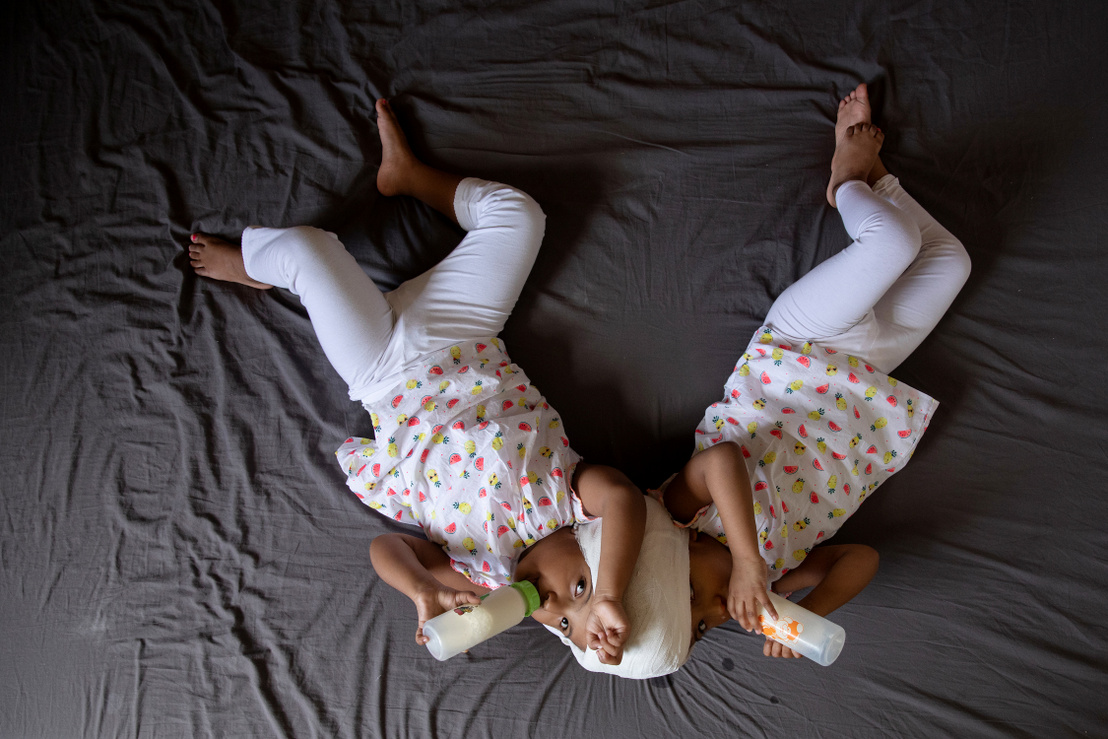



















Ne maradjon le semmiről!
Follow the English edition of Hungary's largest independent news site on Facebook.